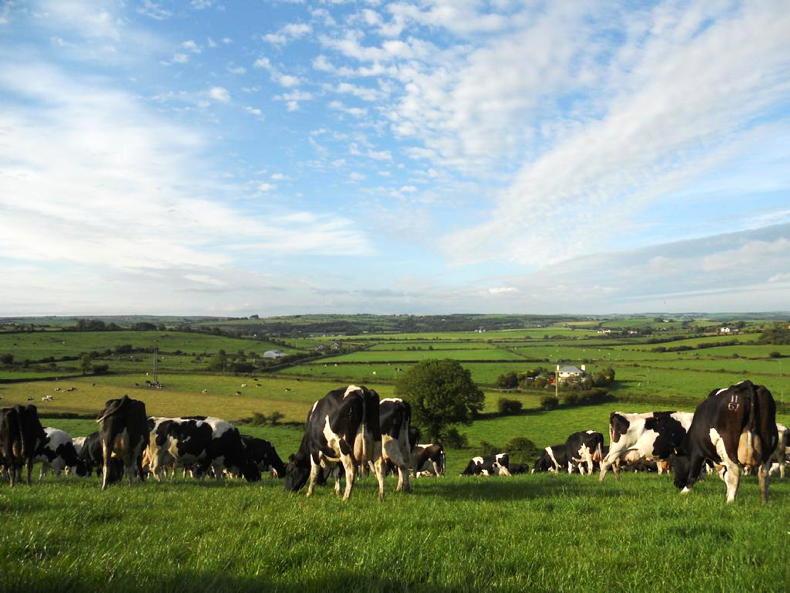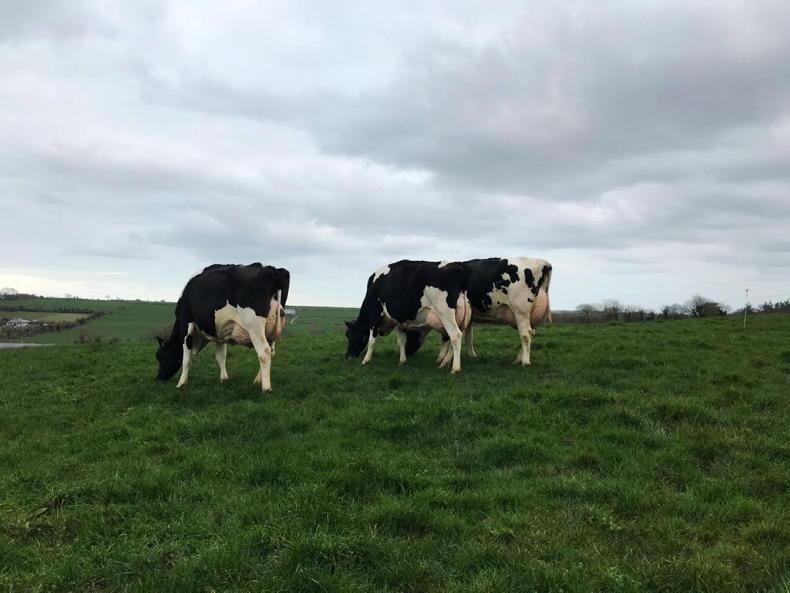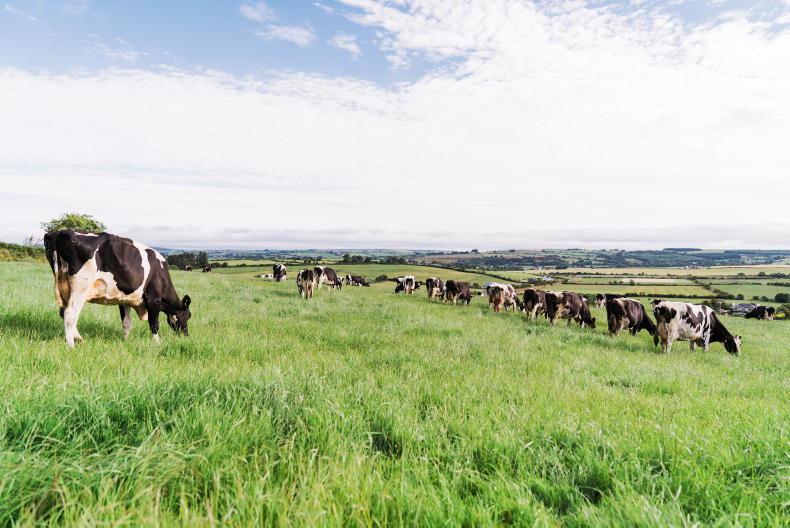Mervyn and Marian Helen farm in Clonakilty, Co Cork, alongside Mervyn’s parents, Richard and Marion. The Helens have a long-standing pedigree registered herd called the Kilgarriffe Herd. They milk 350 pedigree Holstein cows on the west Cork farm and are a dual supplier to Clóna Dairies and Lisavaird Co-op where they have a liquid milk contract with Clóna.
Clóna Dairies is owned by three of the four west Cork co-ops – Lisvaird, Barryroe and Bandon – which have suppliers between Cork city and Clonakilty. Clóna is solely dependent on liquid milk production to operate.
Mervyn’s grandparents purchased the farm in the 1940s and they entered liquid milk in the early 1970s. With over 50 years supplying liquid milk, it’s clear the Helens are experienced in this system.
Last year, the herd delivered an impressive 9,500 litres per cow on average at 4.2% fat and 3.54% protein. This equates to 735kg MS per cow. All cows are inseminated with Holstein Friesian genetics apart from the lower milk solid-producing cows which are bred to beef bulls.
Cows are on a total mix ration consisting of grass and maize silage, fodder beet and concentrate feeds based around wheat, soya bean meal and soya hulls.
Mervyn grows 14 acres of fodder beet every year on an outblock. Like many farms, the Kilgarriffe farm is fragmented. The milking platform is limited so the outside blocks are a key part of the system, growing silage, maize and beet and providing high-quality forages to the herd during the winter.

The Helens have a long-standing pedigree-registered herd, called the Kilgarriffe Herd.
Mervyn says there are over 90 acres of maize grown each year between what they grow themselves and bought-in maize.
The cows are also fed meal through a feed-to-yield system in the milking parlour all year round. This rewards cows with extra meal dependant on their yield.
Value
Alongside the hustle and bustle of milking 350 cows, the Helens also rear 30 pedigree Holstein stock bulls each year. This side enterprise creates a market and added value to their bull calves. They also rear all dairy heifers.
Surplus heifers are sold as calves, bulling heifers along with having a sale every year in April where they sell heifers that have calved.
Mervyn is worried about the future of liquid milk in Ireland in a time where costs on farm are so high, milk price has taken a cut and new nitrates regulation are being introduced. He recently attended a Teagasc winter milk open day in Johnstown Castle.
“Teagasc outlined that the costs associated with liquid milk production have increased by 23% since 2021. This cannot and will not be carried by farmers,” says Mervyn.
He expressed his concern for the number of registered liquid milk suppliers, as over the past 10 years the number of National Milk Agency-registered liquid milk suppliers has fallen from 1,800 to 1,200. He also mentioned that 270 farmers in this group supply 50% of the entire liquid milk pool.

With the current lack of a margin in liquid milk production this group will be forced to change to spring milk production.
“The fact that half the milk pool is supplied by 20% of suppliers has to become a real concern for both processors and retailers. As a country we are relying on a very small group of dedicated farmers to supply high-quality milk from freshly calved cows over the winter months,” Mervyn says.
Lack of a margin
He went on to say that with the current lack of a margin in liquid milk production, this group will be forced to change to spring milk production leaving the consumer, retailer and processor without fresh local, National Dairy Council (NDC)-labelled milk on the shelves over the winter months.
“This is an unacceptable situation in a country with over 1.5m cows. Ireland has a reputation for producing the highest-quality, sustainably produced milk in the world.”

Kilgarriffe Herd, Clonakilty.
Mervyn also feels the new nitrates regulations are the second major threat to the liquid milk industry, with the vast majority of suppliers in both derogation and in band three.
These farmers will have no option but to reduce cow numbers to comply with new legislation, which will add to the possible unviability of liquid milk production.
“If we have to cull cows in the herd, for the majority of liquid milk farms this will be the uneconomic winter calving portion of their herd. These regulations have the potential to entirely wipe out the liquid milk pool,” Mervyn says.
Mervyn stressed three key areas he feels can resolve this situation and ensure we have fresh, locally produced milk on shop shelves over the winter.
1 Historically, retailers engaged in trading with liquid milk where it was sold as a loss leader or, at very best, a very low margin to attract footfall. Now that this situation has changed, retailers need to ensure a fairer redistribution of the shelf price of milk. Inflation has ensured that the current premium of 7c/l has now become irrelevant. This compensation has been in place for the last 20 years and has outlived its relevance.
“To ensure retailers have an adequate supply of milk over the winter months I think they need to provide processors with an additional 10c/l on top of the current 7c/l to adequately cover farmers’ costs of production.
“This is only an additional 5c/l on an annualised basis, surely this is a very small price to pay to ensure we have fresh, locally produced milk to drink,” Mervyn says.
2 Suppliers are at a crossroads if they don’t receive a fair premium for producing winter milk.
Suppliers say that if they don’t get an additional 10c/l premium they will exit winter milk.
If this happens, it will lead to a mass exodus of farmers from liquid milk production and the end of another native industry.
3 Consumers need to show their continued support for the industry by purchasing branded NDC-labelled milk from their local dairy such as Clóna, Lee Strand, Centenary Thurles, Tírlan, North Cork Creameries, Aurivo and Avonmore.
Mervyn has a firm view it is critical that measures are put in place immediately to protect the supply of fresh liquid milk. He feels that there needs to be more support for the ever-declining number of dedicated liquid milk producers who milk cows 365 days a year.
“The era of liquid milk producers being asked to produce the highest-quality, sustainably produced milk in the country for very little or no financial reward must come to an end while we still have an industry to talk about,” Mervyn says.
Mervyn and Marian Helen farm in Clonakilty, Co Cork, alongside Mervyn’s parents, Richard and Marion. The Helens have a long-standing pedigree registered herd called the Kilgarriffe Herd. They milk 350 pedigree Holstein cows on the west Cork farm and are a dual supplier to Clóna Dairies and Lisavaird Co-op where they have a liquid milk contract with Clóna.
Clóna Dairies is owned by three of the four west Cork co-ops – Lisvaird, Barryroe and Bandon – which have suppliers between Cork city and Clonakilty. Clóna is solely dependent on liquid milk production to operate.
Mervyn’s grandparents purchased the farm in the 1940s and they entered liquid milk in the early 1970s. With over 50 years supplying liquid milk, it’s clear the Helens are experienced in this system.
Last year, the herd delivered an impressive 9,500 litres per cow on average at 4.2% fat and 3.54% protein. This equates to 735kg MS per cow. All cows are inseminated with Holstein Friesian genetics apart from the lower milk solid-producing cows which are bred to beef bulls.
Cows are on a total mix ration consisting of grass and maize silage, fodder beet and concentrate feeds based around wheat, soya bean meal and soya hulls.
Mervyn grows 14 acres of fodder beet every year on an outblock. Like many farms, the Kilgarriffe farm is fragmented. The milking platform is limited so the outside blocks are a key part of the system, growing silage, maize and beet and providing high-quality forages to the herd during the winter.

The Helens have a long-standing pedigree-registered herd, called the Kilgarriffe Herd.
Mervyn says there are over 90 acres of maize grown each year between what they grow themselves and bought-in maize.
The cows are also fed meal through a feed-to-yield system in the milking parlour all year round. This rewards cows with extra meal dependant on their yield.
Value
Alongside the hustle and bustle of milking 350 cows, the Helens also rear 30 pedigree Holstein stock bulls each year. This side enterprise creates a market and added value to their bull calves. They also rear all dairy heifers.
Surplus heifers are sold as calves, bulling heifers along with having a sale every year in April where they sell heifers that have calved.
Mervyn is worried about the future of liquid milk in Ireland in a time where costs on farm are so high, milk price has taken a cut and new nitrates regulation are being introduced. He recently attended a Teagasc winter milk open day in Johnstown Castle.
“Teagasc outlined that the costs associated with liquid milk production have increased by 23% since 2021. This cannot and will not be carried by farmers,” says Mervyn.
He expressed his concern for the number of registered liquid milk suppliers, as over the past 10 years the number of National Milk Agency-registered liquid milk suppliers has fallen from 1,800 to 1,200. He also mentioned that 270 farmers in this group supply 50% of the entire liquid milk pool.

With the current lack of a margin in liquid milk production this group will be forced to change to spring milk production.
“The fact that half the milk pool is supplied by 20% of suppliers has to become a real concern for both processors and retailers. As a country we are relying on a very small group of dedicated farmers to supply high-quality milk from freshly calved cows over the winter months,” Mervyn says.
Lack of a margin
He went on to say that with the current lack of a margin in liquid milk production, this group will be forced to change to spring milk production leaving the consumer, retailer and processor without fresh local, National Dairy Council (NDC)-labelled milk on the shelves over the winter months.
“This is an unacceptable situation in a country with over 1.5m cows. Ireland has a reputation for producing the highest-quality, sustainably produced milk in the world.”

Kilgarriffe Herd, Clonakilty.
Mervyn also feels the new nitrates regulations are the second major threat to the liquid milk industry, with the vast majority of suppliers in both derogation and in band three.
These farmers will have no option but to reduce cow numbers to comply with new legislation, which will add to the possible unviability of liquid milk production.
“If we have to cull cows in the herd, for the majority of liquid milk farms this will be the uneconomic winter calving portion of their herd. These regulations have the potential to entirely wipe out the liquid milk pool,” Mervyn says.
Mervyn stressed three key areas he feels can resolve this situation and ensure we have fresh, locally produced milk on shop shelves over the winter.
1 Historically, retailers engaged in trading with liquid milk where it was sold as a loss leader or, at very best, a very low margin to attract footfall. Now that this situation has changed, retailers need to ensure a fairer redistribution of the shelf price of milk. Inflation has ensured that the current premium of 7c/l has now become irrelevant. This compensation has been in place for the last 20 years and has outlived its relevance.
“To ensure retailers have an adequate supply of milk over the winter months I think they need to provide processors with an additional 10c/l on top of the current 7c/l to adequately cover farmers’ costs of production.
“This is only an additional 5c/l on an annualised basis, surely this is a very small price to pay to ensure we have fresh, locally produced milk to drink,” Mervyn says.
2 Suppliers are at a crossroads if they don’t receive a fair premium for producing winter milk.
Suppliers say that if they don’t get an additional 10c/l premium they will exit winter milk.
If this happens, it will lead to a mass exodus of farmers from liquid milk production and the end of another native industry.
3 Consumers need to show their continued support for the industry by purchasing branded NDC-labelled milk from their local dairy such as Clóna, Lee Strand, Centenary Thurles, Tírlan, North Cork Creameries, Aurivo and Avonmore.
Mervyn has a firm view it is critical that measures are put in place immediately to protect the supply of fresh liquid milk. He feels that there needs to be more support for the ever-declining number of dedicated liquid milk producers who milk cows 365 days a year.
“The era of liquid milk producers being asked to produce the highest-quality, sustainably produced milk in the country for very little or no financial reward must come to an end while we still have an industry to talk about,” Mervyn says.









 This is a subscriber-only article
This is a subscriber-only article










SHARING OPTIONS: